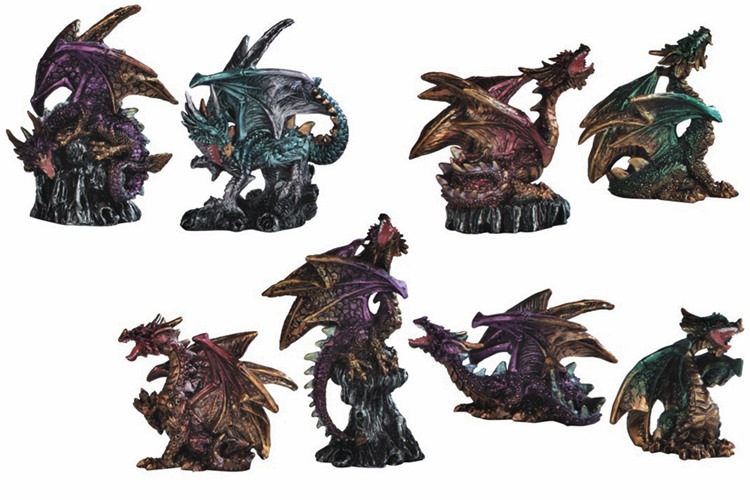Mythical, Fire-Breathing Beasts: What’s the Story of Dragons?
It’s hard not to be a dragon fanatic!
Dragons all over the world hold different meanings and have specific folklore attached to them. Some represent good while others represent evil. Much like fairies, the image of dragons has evolved over time along with civilization.
If you’re interested in our dragon figurines, don’t buy one just yet. First, let’s talk about the world’s most famous dragons. That way your figurine will be all the more meaningful.
Indo-European Dragons
Legends shared across India, the Near East, and Europe all have a similar plotline: the monster and the hero.
In these legends, a scary monster, often in the form of a serpent, threatens the livelihood of communities by eating animals and people. Young, marriageable girls are particularly targeted.
Due to the crisis, a hero emerges. But he often needs supernatural help, such as a Pegasus or a magical sword. Sometimes he has superhuman strength like Herakles.
The monster does not always appear in draconian form, but is almost always serpent-like in nature. Some are sea monsters, while others like the Python lurk in rocky chasms.
This archetype solidifies the forever battle between good and evil. More specifically, these stories explain how people moved to new areas by overcoming difficult terrain and perils.
Germanic Dragons
The Germanic dragon flies through the air with huge, strong wings and has the ability to breathe fire when threatened. He loves treasure and gold, hoarding it and sleeping on top of his pile to protect it. This image is well-known to this day, appearing in popular TV shows and movies.
The Germanic dragons are also connected with comets. The dragons flying over Northumbria in 792 were probably comets, but were thought at the time to be a warning sign of the Vikings’ attack on the Lindisfarne monastery.
Beowulf
The Germanic dragon is most well-known from old epics like Beowulf, likely dating back to the 8th century. In Beowulf, the dragon moved into a hoard of treasure that he found in an ancient barrow. Beowulf and Wiglaf worked together to slay the dragon, who was then thrown off a sea cliff.
The Hobbit
J.R.R. Tolkien drew heavily from Beowulf when dreaming up Smaug, a fiery dragon who took over the hoard of the dwarves. Tolkien also added a detail from Fafnir, a dragon from an Old Norse myth.
Fafnir also lies on top of treasure. Just like Smaug, he can talk. When he gets fatally wounded, he warns the hero Sigurd against treachery, tells him ancient knowledge, and predicts disaster if his advice is not taken.
English Folklore
Another kind of European dragon is creeping and poisonous. He doesn't have wings and tends to live in fens, marshes, or caves. He eats cattle and maidens until a hero kills him or a saint banishes him.
These stories are likely connected to the findings of dinosaur fossils and bones. Another theory is that the supposed lairs were located near old battlefields, which explained all of the human bones that got plowed up come spring.
Medieval Dragons
Medieval people believed in dragons the way they believed in exotic animals. Although none of them had ever seen a dragon, enough people knew someone, who had a brother, who had a neighbor, who had a friend...who had seen a dragon.
Miasma and disease, especially associated with fens and marshes, became embodied as evil creatures.
Illness and its metaphorical dragon could be banished by a saint. But most saints were very peaceful and weren't well equipped to battle dragons, so instead, they invoked God to remove the dragons.
Eastern Dragons
The Eastern dragon is one of the most famous dragons in the world. These dragons can be found in religion, mythology, and folklore throughout all of East Asia.
While European dragons were evil, Oriental dragons were guardians who protected heaven, controlled the earth’s elements, and maintained good leadership.
The history of the Chinese dragon dates back to 2100 BC.
Dragon Explanations
Anthropologist David E. Jones suggests that dragon myths originate from the fear of snakes. This fear is coded into our DNA to keep us safe from potential threats in the wild. These stories may have been ways that that internal fear manifested.
There are also obvious benefits to warning children against walking off into the marshes or mountains.
Other dragon myths explain geological features. For example, the Mester StoorWorm was a huge sea dragon who ate seven girls every Saturday. One day, he swallowed a boy and his boat, but the peat set his liver on fire. As he died, his teeth fell out across the ocean and created the island archipelagos.
There is another theory that the rainbow might have been interpreted as a giant serpent, as The Rainbow Serpent is a creator-god in some Aboriginal mythologies.
Final Thoughts
Now that you know the rich history of dragons, you are sure to have a deeper appreciation of your custom dragon figurine.
You can get your dragon figurine customized, personalized, and laser-engraved! This makes a special gift for the dragon nerd in your life- whether it be a loved one or yourself.
Relish in the mysterious world of dragons by bringing one into your own home. Everything ranging from dragon eggs to baby dragons to dragon incense holders can light your house up with the magic of dragons.
As to whether you view your dragon as an evil serpent or a guardian of the weather...that much is up to you!

 Default Currency
Default Currency
